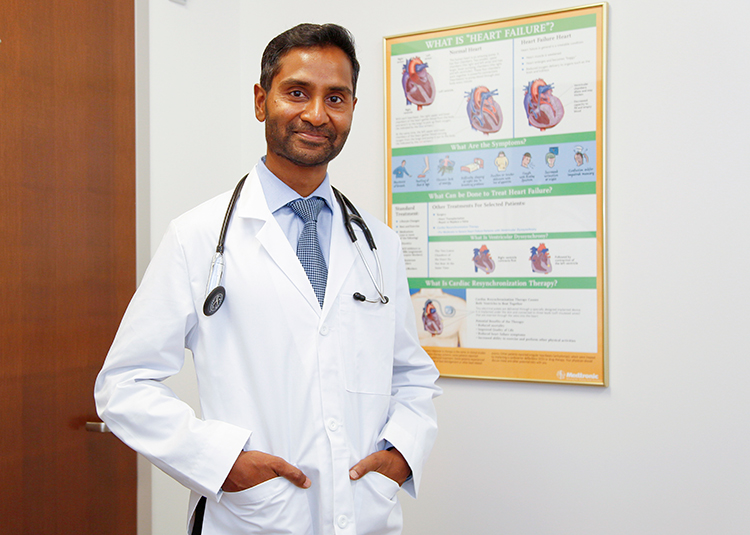
There are few diagnoses more frightening than “heart failure,” but in reality it doesn’t mean the heart has stopped working – it means the heart doesn’t pump blood through the body as well as it should to meet the oxygen demands of tissue and organs.
Heart failure is a major health problem in the United States, affecting about 6 million Americans, and it is the leading cause of hospitalization in people older than 65. But heart failure is not a terminal sentence and there are many modalities to treat the condition.
“A failing heart does not mean a failure forever,” said Cleveland Clinic cardiologist Dr. Raghavendra Makam. “It’s definitely a fork in the road and if you are having symptoms then you need to work on yourself. We have medication and devices that help us manage the condition, but it may be a calling card to make some substantial changes in your lifestyle.”
Heart failure can involve the heart’s left side, right side or both sides, but usually affects the left side first. “Usually, one side of the heart will fail, and the other side can only keep up for so long before it too will fail,” said Dr. Makam.
“Half of the heart failure patients present themselves with pump dysfunction where the action of the pump is weak. The second half are caused by a relaxation malfunction because for a heart to pump, it must also relax. Many patients might have a good pumping function, but they don’t have a good relaxing function.
“The left side of the heart is connected to the lungs, and if the heart is not pumping properly, you’ll see fluid backing up in other parts of the body,” Dr. Makam continued. “Fluid backing up in the feet causes swelling in the feet and legs. Fluid backing up in the whole body causes excessive weight gain, especially around the belly. If it backs up in the lungs the patient may feel like he’s drowning.”
Right-sided ventricular heart failure usually occurs as the result of left-sided failure. When the left ventricle fails, increased fluid pressure is sent back through the lungs, ultimately damaging the heart’s right side. When the right side loses pumping power, blood backs up in the body’s veins causing swelling.
The most common conditions that can lead to heart failure are advanced age, diabetes, obesity, high blood pressure and smoking. Some of the warning signs include weight gain, shortness of breath, swelling of legs, ankles and abdomen, and a dry cough triggered by fluid in the lungs and unusual fatigue.
Early-stage heart failure can be treated with medication to maintain the fluid’s distribution, which affects the entire body. “Fluid management is one of the biggest problems,” Dr. Makam said. “Too much fluid affects the kidneys and lungs because it’s too wet. Too little fluid will cause the patient to feel dehydrated and they can pass out.
“Medication can also be administered to help the heart heal and recover. A weak heart works against blood pressure. We need to regulate the blood pressure and use medication to increase the strength of the heart. Heart rhythm problems can also contribute to the heart reflex and there are medications to control the heart rhythm as well.”
Advanced heart failure management is utilized when medication proves ineffective. Rhythm cardiac resynchronizing intervenes when the left side of the heart and the right side of the heart are not working in unison. The system for the cardiac resynchronization is a device similar to a pacemaker that helps coordinate the right and left side.
Some people with severe heart failure develop arrhythmias or irregular heartbeats and may need implantable defibrillators, or ICDs. These devices are surgically placed to monitor heart rhythm and deliver an electric shock to the heart when a life-threatening abnormal rhythm is detected.
If the heart is still failing after trying medication and prophylactic devices, end-stage intervention may be necessary while waiting for a heart transplant. A left ventricular assist device is a battery-operated, mechanical, pump-like device that’s surgically implanted and helps the pumping ability of a heart that can’t effectively work on its own.
People often have to wait a long time before a suitable heart becomes available and an LVAD can help a weak heart buy time for the patient or, in some cases, eliminate the need for a heart transplant altogether if used in end-stage heart failure when heart transplantation isn’t an option.
Heart transplantation is the holy grail if your heart is failing. Surgeons replace the damaged heart with a healthy one from a donor who has been declared brain dead. During a transplant procedure the surgeon connects the patient to a heart-lung machine which takes over the function of the heart and lungs. The surgeon removes the diseased heart and replaces it with the donor heart, connects the major blood vessels and the new heart is ready to work.
“You can prevent heart disease by reducing risk factors and seeking help early to not only fix the problem for now, but to fix it on a long-term basis,” Dr. Makam said. “Manage your high blood pressure, high glucose and high cholesterol. Maintain a healthy weight. Quit smoking and get tested for any genetic predisposition for development of heart failure.”
Dr. Raghavendra Makam is proud to be part of the Cleveland Clinic Indian River Hospital’s comprehensive heart management team at the Welsh Heart Center. He was awarded fellowships in cardiac critical care from John Hopkins Hospital, cardiology from University of Massachusetts Medical Center and advanced heart and transplants from Jackson Memorial Hospital/University of Miami. The Welsh Heart Center is located at 3450 11th Court, Suite 102.
Dr. Makam can be reached at 772-778-8687.



